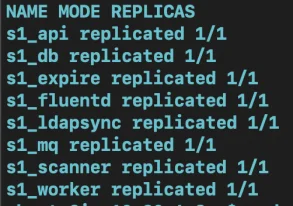Core Services
Core Services
Core Services
Privilege Secure is comprised of the following Docker containers, which each perform a unique task:
- s1_api
- s1_db (single node) OR s1_mongo1, s1_mongo2, s1_mongo3, etc (cluster setup)
- s1_expire
- s1_fluentd
- s1_ldapsync
- s1_mq
- s1_scanner
- s1_worker
Below is the sample output of running
sudo docker service ls | awk -F" " '{print $2,$3,$4}' in a single-node environment. Run sudo
docker service ls` for the complete output:

API Service Description
Privilege Secure is built from the ground up on a REST based API. This service runs the web portal and the UI through which Users and Administrators interact with the UI, as well as all of the API which can be called to leverage all of the features of Privilege Secure from any external source capable of ingesting JSON data returned from the calls.
How to check the status of the service from the command line:
sudo docker service ps s1_api
DB/Mongo Service Description
Privilege Secure runs MongoDB as its database service. Everything pertinent to Privilege Secure is stored there, and additional data regarding the data structure can be found in the support documentation included in this portal.
How to check the status of the service from the command line:
-
sudo docker service ps s1_db(single node)OR
-
sudo docker service ps s1_mongo1(cluster, incrementingmongo1by 1 for every node in the cluster)
Expire Service Description
There are a number of reasons why Privilege Secure may not be able to contact a specific node on the
network at any given time - laptops coming on and off the network, firewall rules changing, network
outages, etc. When this happens and Privilege Secure is waiting to execute a command for this
machine such as expiring an active JITA session, but cannot connect to a resource at the time
required, the event passes into the expire queue where it is periodically attempted again until
either successful, or times out as an error. The expire container is responsible for managing
expiration requests, both active and pending.
How to check the status of the expire service from the command line:
sudo docker service ps s1_expire
Fluentd Service Descirption
Fluentd is the log aggregation tool Privilege Secure uses. It gathers all of the logging information from the other Docker containers, aggregates it, formats it, and then spits it out via syslog to a SIEM. Syslog is the default format, however for Splunk specifically fluentd uses the "HEC (HTTP Event Collector)" to directly send logs into Splunk.
How to check the status of the fluentd service from the command line:
sudo docker service ps s1_fluentd
LDAPSync Service Description
This service performs the baseline sync which takes place with Active Directory (AD). An initial
sync with AD has essentially 5 stages which are clearly visible in the svc-ldap.log file:
- Initial connection and authentication
- Sync of AD Computer objects
- Sync of AD User objects
- Sync of AD Group objects
- Message of sync completed
Once these initial sync messages have taken place, the ldapsync checks again with the configured domain(s) every 60 seconds and tracks any new and additional changes.
How to check the status of the ldapsync service from the command line:
sudo docker service ps s1_ldapsync
MQ Service Description
MQ stands for "Messaging Queue" and it is the container which handles intra-container communications
and prioritization of messages.
How to check the status of the service from the command line:
sudo docker service ps s1_mq
Scanner Service Description
Privilege Secure is a continuous scanning solution for Privileged Access Management, and the scanner
container is the service responsible for carrying that out. It is its own independent container,
solely responsible for scanning the network and updating all database records according to what it
discovers.
How to check the status of the scanner service from the command line:
sudo docker service ps s1_scanner
Worker Service Description
The worker service is responsible for carrying out active requests. Some of what is does, such as re-scanning an endpoint, and where relevant enforcing Protect Mode, overlaps with the scanner container. However, most of what the worker container is responsible for is enforcing changes which are either manually requested by a user or requested via the API. For example, when searching for a computer in the "Grant Access" pane, the majority fo the options present for an endpoint are executed by the worker container - Rescan, Remove Admin, Set/Remove Persistent, Request Access, etc.
How to check the status of the worker service from the command line:
sudo docker service ps s1_worker
Info: What's Different About Domain Controllers?
Info: What's Different About Domain Controllers?
Info: What's Different About Domain Controllers?
Domain Controllers operate very differently inside of a network than desktop and server endpoints. Because they are the source of truth for essential elements of the directory (users, groups and computers), they operate uniquely -- which places them outside of the control of Privilege Secure.
Domain Controllers:
- Report their hostname as the domain name and not their actual hostname, so when Privilege Secure is attempting to scan this resource it will very likely contain the following error:
DOMAIN\Example-Hostname: wrong_host
"System hostname does not match: (u'Example-Hostname', [u'DOMAIN', u'Builtin'])"
- Within the "System hostname does not match: (u'Example-Hostname', [u'DOMAIN', u'Builtin'])" message, the 'Example-Hostname' refers to the hostname that Privilege Secure thinks it is reaching out to at the last known IP, and the 'DOMAIN' at the first index of the subsequent array represents the actual hostname that is being returned from that IP.
- Cannot have Protect Mode enabled on them. Since the only users who show up in the Local Admin group on a Domain Controller are the Domain Admins, we generally recommend against scanning them as well. To eliminate this error from an environment, set the Scan Mode to "false" for the Domain Controllers.
Best practice recommendations
- Use domain admin accounts to ONLY administer the domain controller and NOTHING else.
- Keep domain admins to a very tightly controlled group.